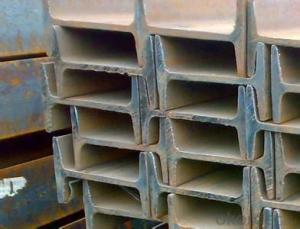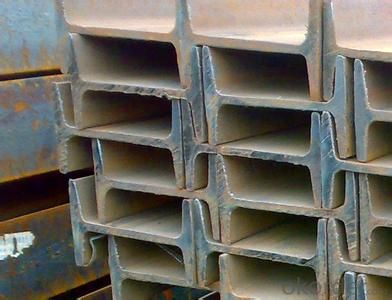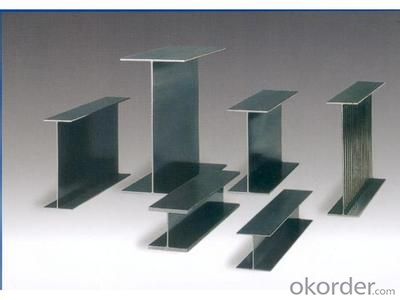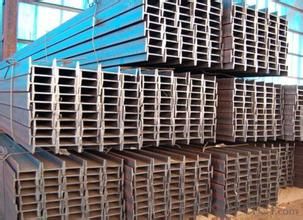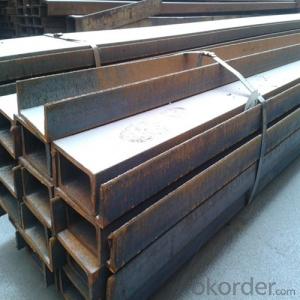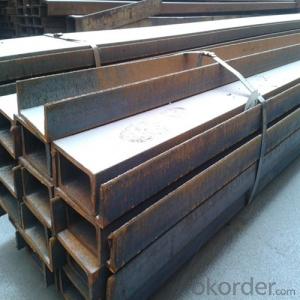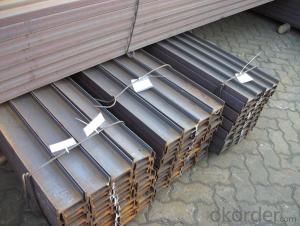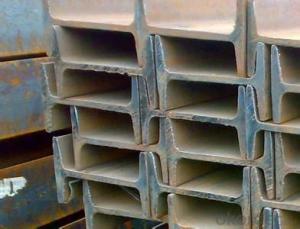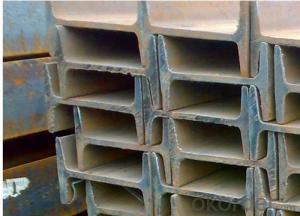High Quality BS Standard Structure Steel I Beam Details
- Loading Port:
- Tianjin
- Payment Terms:
- TT or LC
- Min Order Qty:
- 500 m.t.
- Supply Capability:
- 20000 m.t./month
OKorder Service Pledge
OKorder Financial Service
You Might Also Like
Product Description:
OKorder is offering High Quality BS Standard Structure Steel I Beam Detailsat great prices with worldwide shipping. Our supplier is a world-class manufacturer of steel, with our products utilized the world over. OKorder annually supplies products to European, North American and Asian markets. We provide quotations within 24 hours of receiving an inquiry and guarantee competitive prices.
Product Applications:
High Quality BS Standard Structure Steel I Beam Details are ideal for structural applications and are widely used in the construction of buildings and bridges, and the manufacturing, petrochemical, and transportation industries.
Product Advantages:
OKorder's High Quality BS Standard Structure Steel I Beam Details are durable, strong, and resist corrosion.
Main Product Features:
· Premium quality
· Prompt delivery & seaworthy packing (30 days after receiving deposit)
· Corrosion resistance
· Can be recycled and reused
· Mill test certification
· Professional Service
· Competitive pricing
Product Specifications:
Manufacture: Hot rolled
Grade: Q195 – 235
Certificates: ISO, SGS, BV, CIQ
Length: 6m – 12m, as per customer request
Packaging: Export packing, nude packing, bundled
Chinese Standard (H*W*T) | Weight (Kg/m) | 6m (pcs/ton) | Light I (H*W*T) | Weight (Kg/m) | 6m (pcs/ton) | Light II (H*W*T) | Weight (Kg/m) | 6M |
100*68*4.5 | 11.261 | 14.8 | 100*66*4.3 | 10.13 | 16.4 | 100*64*4 | 8.45 | 19.7 |
120*74*5.0 | 13.987 | 11.9 | 120*72*4.8 | 12.59 | 13.2 | 120*70*4.5 | 10.49 | 15.8 |
140*80*5.5 | 16.89 | 9.8 | 140*78*5.3 | 15.2 | 10.9 | 140*76*5 | 12.67 | 13.1 |
160*88*6 | 20.513 | 8.1 | 160*86*5.8 | 18.46 | 9 | 160*84*5.5 | 15.38 | 10.8 |
180*94*6.5 | 24.143 | 6.9 | 180*92*6.3 | 21.73 | 7.6 | 180*90*6 | 18.11 | 9.2 |
200*100*7 | 27.929 | 5.9 | 200*98*6.8 | 25.14 | 6.6 | 200*96*6.5 | 20.95 | 7.9 |
220*110*7.5 | 33.07 | 5 | 220*108*7.3 | 29.76 | 5.6 | 220*106*7 | 24.8 | 6.7 |
250*116*8 | 38.105 | 4.3 | 250*114*7.8 | 34.29 | 4.8 | 250*112*7.5 | 28.58 | 5.8 |
280*122*8.5 | 43.492 | 3.8 | 280*120*8.2 | 39.14 | 4.2 | 280*120*8 | 36.97 | 4.5 |
300*126*9 | 48.084 | 3.4 | 300*124*9.2 | 43.28 | 3.8 | 300*124*8.5 | 40.87 | 4 |
320*130*9.5 | 52.717 | 3.1 | 320*127*9.2 | 48.5 | 3.4 | |||
360*136*10 | 60.037 | 2.7 | 360*132*9.5 | 55.23 | 3 |
FAQ:
Q1: Why buy Materials & Equipment from OKorder.com?
A1: All products offered byOKorder.com are carefully selected from China's most reliable manufacturing enterprises. Through its ISO certifications, OKorder.com adheres to the highest standards and a commitment to supply chain safety and customer satisfaction.
Q2: How do we guarantee the quality of our products?
A2: We have established an advanced quality management system which conducts strict quality tests at every step, from raw materials to the final product. At the same time, we provide extensive follow-up service assurances as required.
Q3: How soon can we receive the product after purchase?
A3: Within three days of placing an order, we will begin production. The specific shipping date is dependent upon international and government factors, but is typically 7 to 10 workdays.
Q4: What makes stainless steel stainless?
A4: Stainless steel must contain at least 10.5 % chromium. It is this element that reacts with the oxygen in the air to form a complex chrome-oxide surface layer that is invisible but strong enough to prevent further oxygen from "staining" (rusting) the surface. Higher levels of chromium and the addition of other alloying elements such as nickel and molybdenum enhance this surface layer and improve the corrosion resistance of the stainless material.
Q5: Can stainless steel rust?
A5: Stainless does not "rust" as you think of regular steel rusting with a red oxide on the surface that flakes off. If you see red rust it is probably due to some iron particles that have contaminated the surface of the stainless steel and it is these iron particles that are rusting. Look at the source of the rusting and see if you can remove it from the surface.
Images:
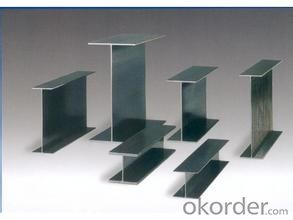
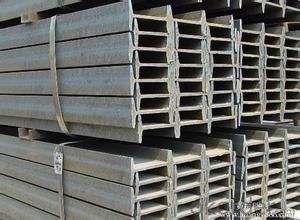
- Q: How do steel I-beams perform in high-humidity environments?
- Steel I-beams perform well in high-humidity environments due to their inherent resistance to moisture. The steel used in I-beams is typically coated with protective finishes, such as galvanization or paint, which act as barriers against moisture penetration. This prevents the steel from coming into direct contact with water or humidity and helps to prevent corrosion. Additionally, steel is a non-porous material, meaning it does not absorb moisture like wood or other organic materials. This characteristic makes steel I-beams less susceptible to swelling, warping, or rotting that can occur in high-humidity conditions. However, in extremely corrosive environments, such as coastal areas with high salt content in the air, additional precautions might be necessary. In such cases, stainless steel or other corrosion-resistant alloys are commonly used to ensure the longevity and performance of the I-beams. Overall, steel I-beams are a reliable choice in high-humidity environments, offering durability, strength, and resistance to moisture-related issues.
- Q: Can steel I-beams be used for wind turbine towers?
- Absolutely! Wind turbine towers can indeed utilize steel I-beams. These I-beams are extensively employed in the construction sector owing to their exceptional robustness and longevity. Their remarkable strength-to-weight ratio renders them ideal for withstanding the weight and impact of wind turbine blades. Moreover, steel is an adaptable material that can be effortlessly shaped and sized to meet the specifications of wind turbine towers. Furthermore, steel I-beams exhibit superior resistance against corrosion, a crucial attribute for structures exposed to the elements. All in all, the structural integrity and dependability of steel I-beams make them an immensely popular choice for wind turbine towers.
- Q: Can steel I-beams be used for industrial shelving?
- Yes, steel I-beams can be used for industrial shelving. Steel I-beams are commonly used in construction and can provide excellent strength and durability for industrial shelving applications. They offer high load-bearing capacity, making them suitable for storing heavy items or equipment. Additionally, the versatility of steel allows for the customization of shelving units to meet specific industry requirements.
- Q: What are the potential cost savings associated with using steel I-beams?
- Using steel I-beams in construction projects offers various potential cost savings. Firstly, steel I-beams possess a high strength-to-weight ratio, enabling them to support heavy loads while utilizing less material compared to other options. This results in cost savings through reduced material expenses and transportation costs. Moreover, steel I-beams exhibit durability and resistance to decay, pests, and fire. Consequently, they have a longer lifespan compared to alternative materials, leading to lower maintenance and replacement costs over time. Additionally, steel I-beams are relatively quick and simple to install, particularly when contrasted with traditional construction methods. This can lead to significant time savings, ultimately translating into reduced labor expenses. Furthermore, steel is a highly recyclable material. In the event of remodeling or demolishing a structure that employs steel I-beams, the beams can be efficiently recycled and reused. This not only reduces waste but also potentially diminishes the overall environmental impact of the project. Lastly, steel I-beams are readily available in standard sizes, streamlining the construction process and minimizing the necessity for customized fabrication. This standardization can yield cost savings by reducing lead times and enhancing production efficiency. In summary, the potential cost savings associated with utilizing steel I-beams encompass reduced material and transportation expenses, decreased maintenance and replacement outlays, expedited installation times, recyclability, and enhanced production efficiency.
- Q: How do steel I-beams perform in high-snow load areas?
- Steel I-beams perform well in high-snow load areas due to their inherent strength and load-bearing capabilities. The I-beam design provides excellent structural support and allows for the distribution of weight across the entire span of the beam. This means that steel I-beams can effectively handle the additional weight and stress caused by heavy snow loads. The high strength-to-weight ratio of steel makes it an ideal material for withstanding snow loads. Steel is much stronger than wood or other building materials, allowing I-beams to maintain their structural integrity under the pressure of heavy snow accumulation. This strength also enables the I-beams to resist bending or buckling, ensuring the stability and safety of the structure. Additionally, steel is a durable material that is highly resistant to corrosion and decay. This is particularly important in high-snow load areas where the snow can melt and create moisture, potentially leading to the deterioration of the structural components. Steel I-beams are not vulnerable to rot or decay, ensuring their long-term performance and reliability in such environments. Furthermore, steel I-beams can be engineered and designed to meet specific snow load requirements. By considering factors such as the anticipated snowfall, snow density, and building design, engineers can calculate the appropriate size and spacing of I-beams to safely support the snow load. This customization ensures that the structure is adequately designed to handle the specific snow load conditions of a given area. In summary, steel I-beams are highly effective in high-snow load areas. Their strength, durability, and ability to distribute weight make them a reliable choice for supporting heavy snow loads. By properly designing and engineering the structure, steel I-beams can provide the necessary stability and safety required in areas prone to significant snow accumulation.
- Q: How are steel I-beams protected against rust?
- Steel I-beams are protected against rust through a process called corrosion protection. There are several methods used to prevent rusting and extend the lifespan of steel I-beams. One common method is the application of a coating or paint on the surface of the I-beams. The coating acts as a barrier between the steel and the surrounding environment, preventing moisture and oxygen from coming into contact with the metal. This helps to inhibit the formation of rust. Another method is the use of galvanization. In this process, the I-beams are dipped into a bath of molten zinc. The zinc coating forms a protective layer on the surface of the steel, acting as a sacrificial barrier. If any part of the steel is exposed due to damage, the zinc coating will corrode instead of the steel, providing ongoing protection against rust. Additionally, some manufacturers may use a combination of coatings and galvanization to provide enhanced protection against rust. These additional layers can further increase the resistance of the I-beams to corrosion. Regular maintenance and inspection also play a crucial role in protecting steel I-beams against rust. Any damage or signs of rust should be promptly addressed to prevent further corrosion. This may involve cleaning, re-coating, or repairing the affected areas. By implementing these protective measures, steel I-beams can have a significantly extended lifespan and maintain their structural integrity over time.
- Q: How are steel I-beams connected in construction?
- Steel I-beams are connected in construction through various methods depending on the specific requirements of the project. The most common methods of connection include welding, bolting, and riveting. Welding is a widely used method to connect steel I-beams. It involves melting the ends of the beams and fusing them together using a high-intensity heat source. This creates a strong and permanent bond between the beams, ensuring structural integrity. Welding is often preferred when the connection needs to be particularly strong and rigid. Bolting is another common method of connection, especially when flexibility and ease of disassembly are desired. Bolts are used to secure the beams together, typically through pre-drilled holes in the flanges or webs of the beams. This method allows for adjustments and modifications during construction and is often used in situations where future alterations may be required. Riveting, although less common in modern construction, is still used in some cases. It involves driving a steel rivet through aligned holes in the beams and then hammering or pressing it to create a permanent connection. Riveting was traditionally used extensively in older structures, and while it is durable and provides a visually appealing aesthetic, it is time-consuming and requires skilled labor. In addition to these methods, other connection techniques such as adhesive bonding and mechanical connectors may also be used in specific situations. Adhesive bonding involves using industrial adhesives to bind the beams together, while mechanical connectors employ specialized connectors like shear plates or end plates to join the beams. Ultimately, the choice of connection method depends on factors such as load requirements, structural design, construction timeline, and budget. Engineers and construction professionals carefully evaluate these factors to determine the most appropriate method of connecting steel I-beams in each construction project.
- Q: What are the considerations for steel I-beam design in high-humidity areas?
- To ensure the structural integrity and longevity of steel I-beams in high-humidity areas, several considerations must be taken into account. The choice of materials is crucial, with stainless steel or galvanized steel often being preferred due to their corrosion resistance properties. These materials have a protective layer that prevents rust or corrosion from weakening the beams. Proper ventilation and drainage systems should be incorporated into the design to prevent moisture accumulation. Moisture can accelerate corrosion, so it is important to allow for proper airflow and drainage to keep the beams dry. This can be achieved through weep holes, vents, or the use of protective coatings or insulation. Regular maintenance and inspection are essential to identify and address any signs of corrosion or damage. High-humidity areas pose a greater risk of corrosion, so a maintenance plan including inspections, cleaning, and repairs should be implemented. Environmental factors in high-humidity areas should also be considered. If the area is prone to saltwater exposure or chemical pollutants, additional precautions may be necessary. This could involve using a higher grade of stainless steel or specialized coatings for enhanced corrosion resistance. Consulting with structural engineers or experts in steel design for high-humidity areas is highly recommended. These professionals can provide valuable insights and guidance in selecting materials, designing drainage systems, and implementing maintenance practices. By considering these factors, steel I-beams in high-humidity areas can be designed to ensure durability and minimize the risk of corrosion, thereby maintaining their structural integrity over time.
- Q: What is the maximum span length for a steel I-beam?
- The maximum span length for a steel I-beam depends on various factors such as the size and type of the I-beam, the load it needs to support, and the desired deflection criteria. Generally, steel I-beams can span up to 60 feet or more, but it is recommended to consult structural engineers or reference design tables to determine the specific maximum span length for a particular I-beam.
- Q: Do I need to stagger a distance between the wing plate splice and the web splice at the butt joint of the I-beam?
- In order not to force the steel column or the steel beam on the same plane, that is, the same weld plane is subjected to force
Send your message to us
High Quality BS Standard Structure Steel I Beam Details
- Loading Port:
- Tianjin
- Payment Terms:
- TT or LC
- Min Order Qty:
- 500 m.t.
- Supply Capability:
- 20000 m.t./month
OKorder Service Pledge
OKorder Financial Service
Similar products
Hot products
Hot Searches
Related keywords
